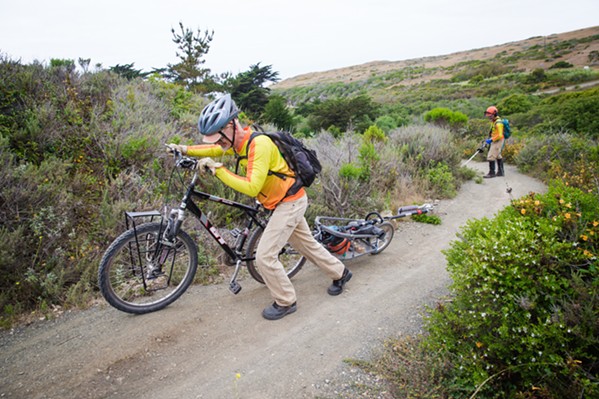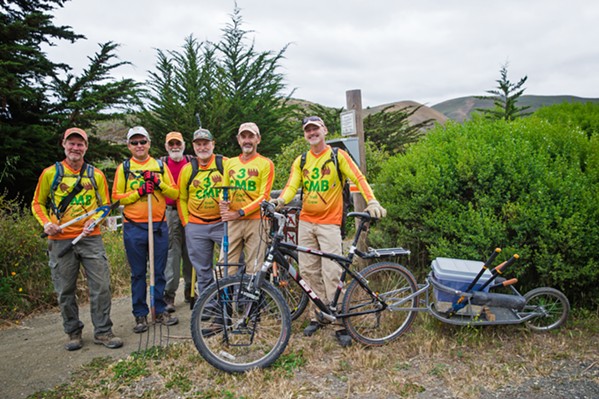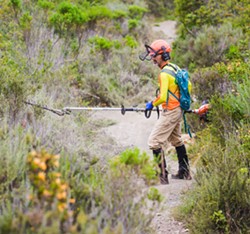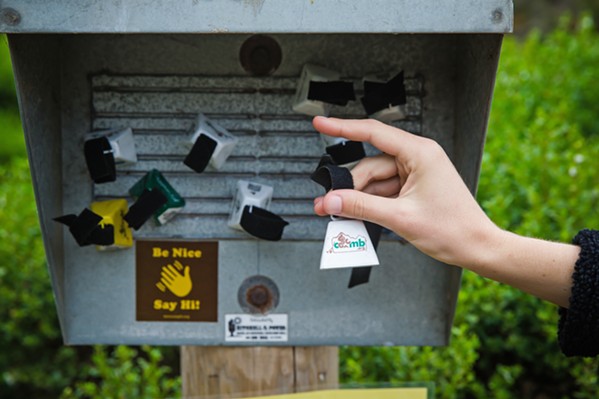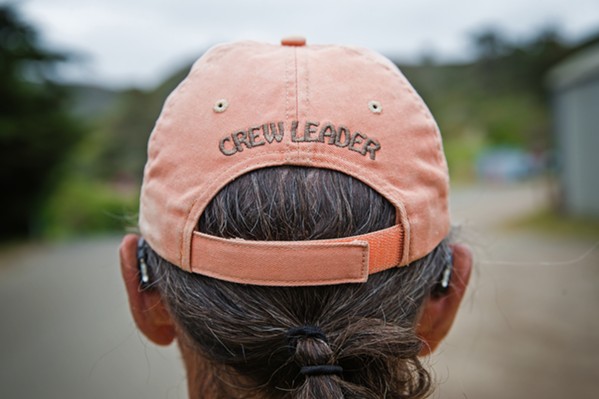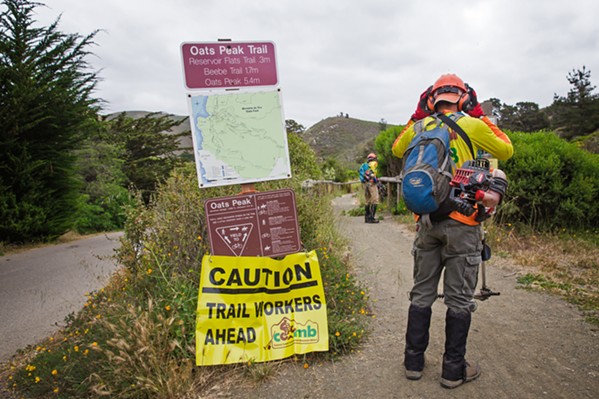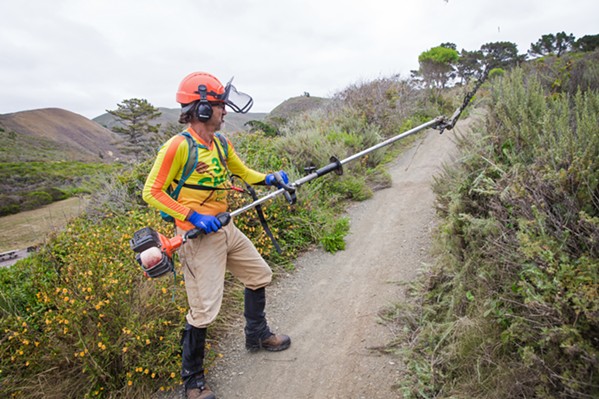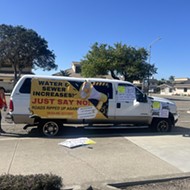Path to nature: Volunteers, nonprofits, and local governments work together to make open space accessible by foot, bike, and horse
By Malea Martin[
{
"name": "Promo Temp Targeted",
"id": "PromoTempTargeted",
"class": "inlineCenter",
"insertPoint": "4",
"component": "15511697",
"requiredCountToDisplay": "0"
},
{
"name": "Ad - Medium Rectangle CC01 - 300x250 - Inline Content",
"class": "inlineCenter",
"insertPoint": "8",
"component": "15582119",
"requiredCountToDisplay": "12"
},{
"name": "Ad - Medium Rectangle LC01 - 300x250 - Inline Content",
"class": "inlineCenter",
"insertPoint": "18",
"component": "15582122",
"requiredCountToDisplay": "22"
},{
"name": "Ad - Medium Rectangle 9 - 300x250 - Inline Content",
"class": "inlineCenter",
"insertPoint": "28",
"component": "15582121",
"requiredCountToDisplay": "32"
}]
It's 8:30 a.m. on a Sunday, and much of San Luis Obispo is just beginning to rouse from sleep. But for Central Coast Concerned Mountain Bikers (3CMB), it's time to get to work.
As the top of the hour nears, volunteers gathered in the parking lot below the Miossi Open Space, home to the city of San Luis Obispo's latest public trail project. While most everyone there is a mountain biker, the group is committed to building and maintaining trails that all user groups—hikers, bikers, runners, equestrians—can sustainably use and enjoy.
Out of the couple of dozen volunteers, their ages ranging from teenagers to those well into their 70s, a handful wore orange 3CMB caps with "crew leader" embroidered on the back, a high distinction in this group. Trail crew leader Kenny McCarthy's hat is so faded that it's almost white. It's shaded his head on more trail work days than he could count.
"To be able to get a crew like this out there is pretty cool," McCarthy said as he swung his row hoe into the ground about a mile up in the Miossi Open Space hills, carving a trail into the hillside that will soon be open to the public.
The volunteers, many with decades of trailblazing experience, are just one vital cog in the well-oiled machine of multi-use trail makers on the Central Coast.
"There's only so many people who can work on trails," said Kathy Redden, 3CMB's equestrian representative. "So having them be multi-use means that the efforts to maintain or build new trails, pretty much all user groups can work on them and benefit from them. ... If we can combine our efforts, it's more efficient and effective."
Catering to multiple user groups at once also comes with its challenges: An equestrian like Redden has different needs than a trail distance runner, and sometimes user groups clash.
"We all need to take advantage of the resources that we have and create good relations between the various user groups," Redden said. "And I think that's one of the biggest things, is educating the various user groups on how we can all best get along and enjoy the trail systems that we have."
As the Central Coast's population swells and outdoor spaces become increasingly crowded, environmental advocates urge people to remember that not all land is suitable for trails. Human access to nature is a privilege, not a right—one that could slip away if we're not careful.
Wide, open spaces
A lot has to happen before 3CMB volunteers can break ground on a new trail. First, you need land.
"What I think a lot of people don't realize is that land trusts play a big role," said Kaila Dettman, executive director of The Land Conservancy of San Luis Obispo County, a nonprofit with a mission to connect people to the land and to each other.
The Land Conservancy's Pismo Preserve—11 miles of trails and panoramic ocean views open to those on foot, bike, and horse—started with land for sale on the open market.
"The seller actually expressed a willingness to sell it for conservation and be patient about it," Dettman said, noting that it was an ideal situation from The Land Conservancy's perspective. "Sometimes the seller wants to [sell their land] instantly. But when we have a seller that's willing to sell it for conservation, and give us a certain amount of time, then we're able to seek out funds to buy that land."
There are grants The Land Conservancy can apply for through the state to help make that happen. There's also a major private fundraising effort that comes into play, Dettman said.
But equally important is the location of the land. Is it accessible to different user groups? Could people walk to the future trailhead? Could they bike? Could a parking lot be built with enough space for equestrians to park their horse trailers?
"We especially have our eye on [land] that will serve areas that don't yet have an abundance of open space," Dettman said. "That was the case with the Pismo Preserve. We purchased that knowing that while the beach is phenomenal, there was very little upland hiking and mountain biking trails, or horseback riding trails, so we felt like that was an area that really needed it and would be accessible to a lot of different people."
The Land Conservancy isn't just interested in buying land for broad public access—conservation underlies everything the organization does.
"We're not strictly an open space, outdoor recreation organization," Dettman said. "We also focus on protecting sensitive habitats. And we want to make sure if we are looking at a property for open space and outdoor recreation, that we'll be able to allow that without harming the resources that are there. Can we build a network of trails that avoids sensitive habitats?"
Driving up Highway 1 from SLO toward the North Coast, miles of scenic, undeveloped land stretch as far as the eye can see. Cows graze near the base of Hollister Peak, and if you drive as far north as Cambria, sometimes you can even spot a zebra, a relic of William Randolph Hearst's exotic animal collection.
But this land is only for looking: While parts of Hollister Peak were protected under a Land Conservancy-led conservation easement in 2018, the land remains privately owned and closed to broad public access.
Land is expensive on the Central Coast, and there's not an abundance for sale, a major barrier for building new trails, said Redden, 3CMB's equestrian representative and a vocal advocate for multi-use trails. She said the Central Coast faces unique challenges compared to other regions in California.
"Up in the Bay Area where there used to be a lot of ranches, some of those now [are maintained] by county parks or State Parks," Redden said. "But we don't have the same conversion of ranches to open space. Because the ranches are still active, they're not going to be building trails. Sometimes you can get permission from ranch owners to allow groups to go onto trails, but it's still not open space."
Dettman agreed that a large proportion of land on the Central Coast remains in private ownership, but she sees cost as the most prohibitive barrier.
"To me, it's more of a public ownership versus private ownership status," Dettman said. "Certainly large properties are for sale right now in our county that would be suitable for open space, but they're very expensive. Ensuring that when we're investing public dollars in open space areas that we are buying the right places is really important."
Seizing the opportunity
When the right piece of land is purchased, the trail-making magic can begin.
The group of volunteers from 3CMB had grown to about 30 at the base of the Miossi Open Space as Sunday morning closed in on 9 a.m. Some arrived by mountain bike; one rolled up in a big white van, its bumper coated with stickers.
Before the squad entered the open space to get to work, an important initiation was in order: 3CMB was about to name a new trail crew leader.
To become a crew leader, volunteers must learn the fundamentals of trail maintenance and design by participating in multiple training sessions and then serving as an assistant crew leader alongside an experienced leader. After reaching crew leader status, leaders can direct their own group of volunteers during trail work days.
That day, 3CMB member Craig Campbell received the honor. Veteran crew leader Paul Reinhardt pulled out a crisp orange hat, signifying Campbell's newfound status. Campbell beamed as the hat was placed on his head.
"There's no money involved," said Christie O'Hara, president of 3CMB. "We're a volunteer organization, so any build work we do is volunteer."
That day, 3CMB was joined by city of SLO park rangers Niels Grether and Basile Inman. The city purchased the Miossi Open Space in 2018, and since then, Grether and Inman have both been deeply involved in what must happen before ground gets broken on a trail day like this one.
"The city has a greenbelt program that was established in the '90s. Basically they're trying to acquire land and put it in permanent conservation that sort of surrounds the city," Grether said. "You're basically putting a limit on the urban sprawl."
The city prioritizes purchasing land that has ecological value: protecting watersheds, sensitive species, or habitats for special status animals, Grether said.
"Once we have the land, we'll do biological surveys [to determine] whatever habitat or animals we're trying to protect," Grether said. "We kind of identify the key areas that we want to protect and keep pristine. Those are the no-fly zones for trails."
Next, it's time to stake out the property.
"I'll just walk around everywhere and find all the cool spots that people are going to want to go to," Grether said.
It could be a sweeping vista, an oak canopy, or even "a really neat boulder," Grether said. The idea is to find the places people are going to want to go, and build trails to get them there. If trails aren't built with human interest in mind, Grether said, people will probably end up going off trail to get to the cool spots—and potentially disturb wildlife or create an unsustainable trail in the process.
"It's like at Cal Poly Canyon with the serenity swing," Grether said. "That's this point of interest that no one built a trail to, so people just hike there. And people tend to just hike straight to the thing they want to get to."
Trails created by repeated human trampling rather than careful planning lead to major erosion issues.
"When you walk on it, you'll trample down the plants and expose the bare soil. When it rains, water flows down the trail, and since it's just straight down the hill, eventually it just turns into a big gully. Then people go to the side of that, so it just gets wider and wider, more and more eroded."
When Grether finds a feature he thinks trail users will be drawn to, he takes note of the GPS coordinates. Then he heads back into the office and lays out all the GPS points onto a geographic information system (GIS), which shows the grade, the percentage by which land slopes up or down.
"We're going to shoot for an average grade of between 4 and 10 percent. Depending what our goals are for that specific trail, I'll draw lines at that percent steepness and kind of connect those points," Grether said. "That gives me a rough idea of are we going to make an out-and-back, are we going to make a loop? Do we need some switchbacks?"
But it's not as simple as a game of connect the dots: Grether also must consider how to keep people out of certain areas.
"We're avoiding those sensitive areas, like sensitive habitats," Grether said. "If there is something—we call it an attractive nuisance—that people are going to want to go to, but there's not really a good way to build a sustainable trail to it, we'll build a trail that keeps it out of view, so no one even knows it's there."
From there, Grether heads back outside. Using pin flags, he'll start to roughly plot where the trail will be—this time on land rather than a computer screen.
"I'll bring in Bob Hill, the city's natural resource manager, and my supervisor, another ranger," Grether said. "We'll walk it together. Bob will bring any biological concerns, like, 'This habitat the trail's going through might be sensitive,' and we reroute."
Once the rough trail alignment is approved, Grether and his team start refining.
"I get pretty technical with it depending on your goals for the trail. For a hiking-only trail or a multi-use trail, you're going to have different considerations," Grether said. "It's about the flow of the trail: You don't want to have a real awkward corner, or a bunch of switchbacks."
Then it's time to build. The city has a mini-bulldozer and excavator for mechanized trail building. But there are certain areas the machines can't reach or that aren't suitable for bulldozing. If a trail is being cut into a steep hillside, Grether said, machines can cause the dirt to cascade down the side of the hill.
That's where 3CMB comes in. The entirely volunteer-based group provides the manpower needed to complete the sections of trail that require manual labor.
During the Sunday morning trail work day, crew leader Steve Lakowske's group of volunteers was assigned to a section of to-be trail about a mile up in the Miossi Open Space hills. He trudged through knee-high foliage, his volunteers in tow, each carrying a tool, until the group reached a series of red pin flags that rangers Grether and Inman had previously set out.
"Scrape all this topsoil off, the organic material, from flag to flag," Lakowske instructed one of his volunteers. "We want a level, just slightly outsloping trail, for drainage."
If you're cutting into a steeper incline, Lakowske explained, you need to create what's called a grade reversal.
"The trail will go up, then down," Lakowske said as he swung his tool down, dirt spraying around his boots and gray cargo pants. "That's how you build a sustainable trail these days. We used to build them with water bars, a piece of wood or a barrier of dirt that directs water off. But they don't last very long, so the better way to do it is to have [water] flowing, sheeting off of the trail."
Sometimes after creating a new section of trail, a 3CMB member will grab their bike and test it out. A trail that's nice to hike on might not be a smooth bike ride, so it's important that different types of users get a feel for it. Even though 3CMB is almost entirely made up of mountain bikers, President O'Hara said her organization prioritizes multi-use.
"We're building trails not just for mountain bikers," O'Hara said. "All the trails that we build are meant to be available for all trail users, unless the land manager doesn't allow horses."
But the work doesn't end at the trailhead: Equally important to building a trail that's accessible to multiple user groups, O'Hara said, is making sure that the groups get along.
Managing conflict
"I think what makes [the Central Coast] different from a lot of other areas is that our user groups, for the most part, all get along: hikers, mountain bikers, and equestrians," O'Hara said. "Marin [County] is one of the common places I talk about that has a huge issue with multi-use trails and different user groups. There's a lot of conflict up there. Sometimes you get user groups that don't want mountain bikers on the trail. They argue that they're too fast or disturbing the trail, they're scaring hikers."
O'Hara credits 3CMB's bell box program for helping to curb that issue locally. The organization implemented the program in 2010 on SLO city trails and in Montaña de Oro. The boxes are placed at trailheads or high traffic areas and frequently replenished with bike bells by 3CMB volunteers. Mountain bikers are encouraged to take a bell and strap it to their handlebars so other trail users know when they're coming.
When it comes to trail etiquette, it's generally accepted that hikers yield to equestrians, and bikers yield to hikers and equestrians.
"I think we've had really good success," O'Hara said. "I just got an email from an equestrian group that was out riding on a Saturday at Montaña de Oro, and they said there were over 20 mountain bikers out there, and every single one of them had stopped and were super nice and were wearing bells."
But startling other user groups isn't the only thing mountain bikers catch some flak for. Some environmental groups have concerns about bikers'—and other user groups'—impact on wildlife, even when they stay on the trail.
"I can't believe how much opposition there was when the three women approached [SLO City] Council to try and have evening access on one part of the city trails," O'Hara said. "There were so many people that came out against that, and I was so surprised by that."
SLO City Council voted narrowly in 2021 to make its Cerro San Luis winter night hiking and biking program permanent. The Sierra Club was a vocal opponent of the program.
"There's no question that they're disruptive to nature," said Sue Harvey, chair of the Conservation Committee of the Sierra Club's Santa Lucia Chapter.
Harvey said that even when bikers and hikers stay on the trails, animals will "either go away from the area or they don't come back as quickly, or they're there in lower numbers. If it's areas where they're eating or nesting it can be especially problematic."
Harvey doesn't oppose trail access all together. In fact, she believes that respectful trail use by all user groups can bolster people's appreciation for nature and teach them about conservation. But from Harvey's perspective, extending those ventures into the nighttime is crossing a line.
"We're looking at an issue of too much use of the resource," Harvey said. "You're disturbing the animals during the day, and they don't even get to get away from you during the night. Once you open that up to night hiking or mountain biking, then 24 hours a day their habitat is disturbed."
She likened it to living next to a construction site.
"Even seven or eight hours a day, it really has impacts on a person," Harvey said. "Then if that's going on all night—there's parallels there."
Despite The Sierra Club's opposition, the city legalized night hiking and biking on Cerro San Luis. SLO Mayor Erica Stewart was the swing vote.
"It really comes down to, it's less than 3 percent of our 4,000 acres [of open space]," New Times reported Stewart saying at the time. "It's a very small, nominal amount, which makes me say, 'OK, this seems like a compromise we can make.'"
Finding a middle ground
"Of course, there's always opposition," O'Hara said—whether it's conflict between user groups or disagreements over striking the right balance between human access and environmental protection.
But one thing most stakeholders seem to agree on is that maintaining sustainable multi-use trails hinges on education. Sometimes, users just don't realize the impacts their trail use has on the environment and each other.
"Often the issue gets pitted between the two sides," Harvey said. "I'm not sure bike riders or hikers or anybody out in nature understands the extent to which it's disruptive to nature. I think most people support [conservation], but you need to know what needs to be protected, how best to protect it, and how you're going to modify your behavior to accomplish that end."
The city of SLO approaches all its trail making with a "conservation first" mindset, park ranger Grether said.
"It's a privilege," not a right, to access nature, he said. "But I think it's important for people to be able to get out and see things, and appreciate it. Because there's a lot of people right now that are like, yes, we value the ecology and all the open spaces around us, because they've had a chance to enjoy those. But without getting the next generation outside to appreciate what's out here and learn to love it, the conservation itself might not be sustainable."
"With trail building, we are creating the next generation of conservationists." Δ
Reach Contributor Malea Martin through the editor at [email protected].
Latest in News
Readers also liked…
-

SLO police identify alleged driver who hit and killed couple
Dec 22, 2022 -

When the levee breaks: Oceano residents, county officials walk a tightrope of regulations to manage Arroyo Grande Creek, which some say led to the levee's failure in January
May 18, 2023 -

Cal Poly report highlights offshore wind's potential to spur green energy transition
Jun 8, 2023

